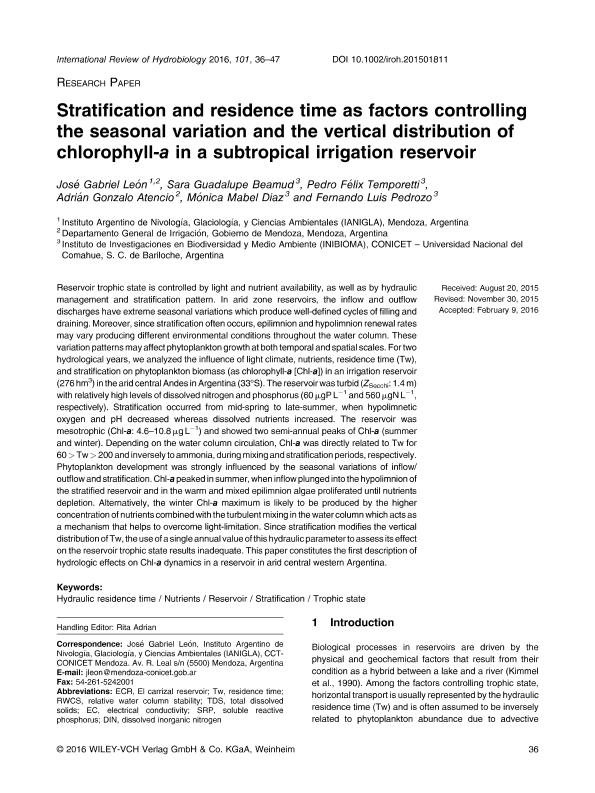Artículo
Stratification and residence time as factors controlling the seasonal variation and the vertical distribution of chlorophyll-a in a subtropical irrigation reservoir
León, José Gabriel ; Beamud, Sara Guadalupe
; Beamud, Sara Guadalupe ; Temporetti, Pedro Felix
; Temporetti, Pedro Felix ; Atencio, Adrian Gonzalo
; Atencio, Adrian Gonzalo ; Diaz, Monica Mabel
; Diaz, Monica Mabel ; Pedrozo, Fernando Luis
; Pedrozo, Fernando Luis
 ; Beamud, Sara Guadalupe
; Beamud, Sara Guadalupe ; Temporetti, Pedro Felix
; Temporetti, Pedro Felix ; Atencio, Adrian Gonzalo
; Atencio, Adrian Gonzalo ; Diaz, Monica Mabel
; Diaz, Monica Mabel ; Pedrozo, Fernando Luis
; Pedrozo, Fernando Luis
Fecha de publicación:
04/2016
Editorial:
Wiley VCH Verlag
Revista:
International Review of Hydrobiology
ISSN:
1434-2944
Idioma:
Inglés
Tipo de recurso:
Artículo publicado
Clasificación temática:
Resumen
Reservoir trophic state is controlled by light and nutrient availability, as well as by hydraulic management and stratification pattern. In arid zone reservoirs, the inflow and outflow discharges have extreme seasonal variations which produce well-defined cycles of filling and draining. Moreover, since stratification often occurs, epilimnion and hypolimnion renewal rates may vary producing different environmental conditions throughout the water column. These variation patterns may affect phytoplankton growth at both temporal and spatial scales. For two hydrological years, we analyzed the influence of light climate, nutrients, residence time (Tw), and stratification on phytoplankton biomass (as chlorophyll-a [Chl-a]) in an irrigation reservoir (276hm3) in the arid central Andes in Argentina (33°S). The reservoir was turbid (ZSecchi: 1.4m) with relatively high levels of dissolved nitrogen and phosphorus (60μgPL-1 and 560μgNL-1, respectively). Stratification occurred from mid-spring to late-summer, when hypolimnetic oxygen and pH decreased whereas dissolved nutrients increased. The reservoir was mesotrophic (Chl-a: 4.6-10.8μgL-1) and showed two semi-annual peaks of Chl-a (summer and winter). Depending on the water column circulation, Chl-a was directly related to Tw for 60>Tw>200 and inversely to ammonia, during mixing and stratification periods, respectively. Phytoplankton development was strongly influenced by the seasonal variations of inflow/outflow and stratification. Chl-a peaked in summer, when inflow plunged into the hypolimnion of the stratified reservoir and in the warm and mixed epilimnion algae proliferated until nutrients depletion. Alternatively, the winter Chl-a maximum is likely to be produced by the higher concentration of nutrients combined with the turbulent mixing in the water column which acts as a mechanism that helps to overcome light-limitation. Since stratification modifies the vertical distribution of Tw, the use of a single annual value of this hydraulic parameter to assess its effect on the reservoir trophic state results inadequate. This paper constitutes the first description of hydrologic effects on Chl-a dynamics in a reservoir in arid central western Argentina.
Palabras clave:
Hydraulic Residence Time
,
Nutrients
,
Reservoir
,
Stratification
,
Trophic State
Archivos asociados
Licencia
Identificadores
Colecciones
Articulos(INIBIOMA)
Articulos de INST. DE INVEST.EN BIODIVERSIDAD Y MEDIOAMBIENTE
Articulos de INST. DE INVEST.EN BIODIVERSIDAD Y MEDIOAMBIENTE
Citación
León, José Gabriel; Beamud, Sara Guadalupe; Temporetti, Pedro Felix; Atencio, Adrian Gonzalo; Diaz, Monica Mabel; et al.; Stratification and residence time as factors controlling the seasonal variation and the vertical distribution of chlorophyll-a in a subtropical irrigation reservoir; Wiley VCH Verlag; International Review of Hydrobiology; 101; 1-2; 4-2016; 36-47
Compartir
Altmétricas



